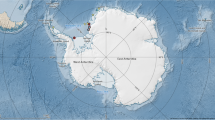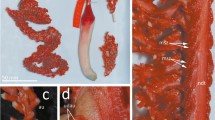Abstract
A new species of the sea pen genus Scytalium Herklots, 1858, is proposed based on the morphological and molecular study of a colony collected during the Océano Profundo 2018 cruise to the Caribbean Sea (NW Atlantic). The new species, Scytalium herklotsi sp. nov., is characterized by its well-developed and overlapping polyp leaves (up to 68 mm in length and 27 mm in width), the presence of eight spiculated large digitiform processes at the distal part of the basal portion of autozooids, the axis rounded in cross section, the numerous siphonozooids in a continuous band of 3–6 rows along the latero-dorsal area of the rachis, and up to 3 rows between contiguous polyp leaves, among other features. An additional unrecorded type of sclerites is reported from the pharynx of autozooids, probably also present in other species of the genus. Scytalium herklotsi sp. nov. is the first species of the genus recorded so far from the Atlantic Ocean, all other described species being Indo-West Pacific. The new species is also the deepest record of a Scytalium species (ca 500 m in depth); the previous published records range from 10 to 206 m in depth. A molecular comparison based on a set of concatenated sequences of four markers (three mitochondrial genes (mtMutS, ND2, and Cox1) and a nuclear segment (28S)) relates the new species to other published sequences attributed to Scytalium species, within the named Clade II of previous general phylogenetic studies on the octocoral Order Pennatulacea.







Similar content being viewed by others
References
Balss H (1909) Über Pennatuliden des Münchener Museums. Zool Anz 34(113/14):423–431
Balss H (1910) Japanische Pennatuliden. Abh Math Phys Kl K Bayer Ak Wiss 1(10, suppl.):1–106
Bayer FM, Stefani J (1988) Primnoidae (Gorgonacea) de Nouvelle-Caledonie. Bull Mus Natl Hist Nat 10(A)3:449–476
Bayer FM, Grasshoff M, Verseveldt J (1983) Illustrated trilingual glossary of morphological and anatomical terms applied to Octocorallia. Brill/ Backhuys, Leiden
Braet F, Zanger R, Wisse E (1997) Drying cells for SEM, AFM and TEM by hexamethyldisilazane: a study on hepatic endothelial cells. J Microsc 186(1):84–87
Cordeiro R, McFadden C, van Ofwegen L, Williams G (2021) World list of octocorallia. Scytalium Herklots, 1858. World Register of Marine Species. http://www.marinespecies.org/aphia.php?p=taxdetails&id=205981. Accessed 30 Mar 2021
Dolan E, Tyler PA, Yesson C, Rogers AD (2013) Phylogeny and systematics of deep-sea sea pens (Anthozoa: Octocorallia: Pennatulacea). Mol Phylogenet Evol 69(3):610–618. https://doi.org/10.1016/j.ympev.2013.07.018
France SC, Hoover LL (2002) DNA sequences of the mitochondrial COI gene have low levels of divergence among deep-sea octocorals (Cnidaria: Anthozoa). Hydrobiologia 471:149–155. https://doi.org/10.1023/A:1016517724749
García-Cárdenas FJ, Núñez-Flores M, López-González PJ (2020) Molecular phylogeny and divergence time estimates in pennatulaceans (Cnidaria: Octocorallia: Pennatulacea). Sci Mar 84:317–330. https://doi.org/10.3989/scimar.05067.28A
Gray JE (1860) Revision of the family Pennatulidae, with descriptions of some new species in the British Museum. Ann Mag Nat Hist Ser 35:20–25
Gray JE (1870) Catalogue of sea-pens or Pennatulariidae in the collection of the British Museum, London. https://doi.org/10.5962/bhl.title.11307
Haeckel E (1866) Generelle Morphologie der organismen. Georg Reimer. Berlin
Herklots JA (1858) Notices pour servir à l’étude des polypiers nageurs ou pennatulidés. Bijdr Dierkd 7:1–31
Hickson SJ (1916) The Pennatulacea of the Siboga Expedition, with a general survey of the order. Siboga Exped Monogr 14(77):1–265
Huelsenbeck JP, Ronquist F (2001) MrBAYES: Bayesian inference of phylogenetic trees. Bioinformatics 17:754–755. https://doi.org/10.1093/bioinformatics/17.8.754
Imahara Y, Namikawa H (2018) Preliminary report on the octocorals (Cnidaria: Anthozoa: Octocorallia) from the Ogasawara Islands. Mem Natl Mus Nat Sci Tokyo 52:65–94
Kölliker RA (1869-72) Anatomisch-Systematische Beschreibung der Alcyonararien. I. Die Pennatuliden. Abh Senckenb Naturforsch Ges 7–8:1–458
Kölliker RA (1880) Report on the Pennatulida dredged by H. M. S. Challenger during the years 1873-1876. Rep Sci Res Voy HMS Challenger 1873-76. Zoology 1(2):1–41
Kükenthal W (1915) Pennatularia. Das Tierreich. Verlag von R. Friedländer und Sohn, Berlin
Kükenthal W, Broch H (1911) Pennatulacea. Wiss Erg Deuts Tiefsee-Exped "Valdivia" 13(2):113–576
Kushida Y, Reimer JD (2018) Molecular phylogeny and diversity of sea pens (Cnidaria: Octocorallia: Pennatulacea) with a focus on shallow water species of the northwestern Pacific Ocean. Mol Phylogenet Evol 131:233–244. https://doi.org/10.1016/j.ympev.2018.10.032
Lamarck JBPA (1816) Histoire naturelle des animaux sans vertèbres, Paris
Linnaeus C (1758) Systema naturae. Editio decima, reformata, Holmiae
López-González PJ (2020) A new calcaxonian genus and family for Trichogorgia utinomii Cordeiro, 2019 (Octocorallia, Alcyonacea): new records of a scleriteless gorgonian species from Antarctica. Mar Biodivers 50:96. https://doi.org/10.1007/s12526-020-01109-0
McFadden CS, Tullis ID, Hutchinson MB et al (2004) Variation in coding (NADH dehydrogenase subunits 2, 3, and 6) and noncoding intergenic spacer regions of the mitochondrial genome in Octocorallia (Cnidaria: Anthozoa). Mar Biotechnol 6:516–526. https://doi.org/10.1007/s10126-002-0102-1
Nation JL (1983) A new method using hexamethyldisilazane for preparation of soft insect tissues for Scanning Electron Microscopy. Stain Technol 58(6):347–351
Rambaut A, Drummond AJ, Xie D, Baele G, Suchard MA (2018) Posterior summarization in Bayesian phylogenetics using Tracer 1.7. Syst Biol 67:901–904. https://doi.org/10.1093/sysbio/syy032
Richiardi S (1869) Monografia della famiglia dei Pennatularii. Arch Zool Anat Fisiol Turin (2)1:1–150
Ronquist F, Huelsenbeck JP (2003) MrBayes 3: Bayesian phylogenetic inference under mixed models. Bioinformatics 19(12):1572–1574
Sánchez J, McFadden CS, France S, Lasker H (2003) Molecular phylogenetic analyses of shallow-water Caribbean octocorals. Mar Biol 142:975–987. https://doi.org/10.1007/s00227-003-1018-7
Shively S, Miller WR (2009) The use of HMDS (hexamethyldisilazana) to replace Critical Point Drying (CPD) in the preparation of tardigrades for SEM (Scanning Electron Microscope) imaging. Trans Kans Acad Sci 112(3/4):198–200. https://doi.org/10.1660/062.112.0407
Tamura K, Stecher G, Peterson D, Filipski A, Kumar S (2013) MEGA6: Molecular Evolutionary Genetics Analysis Version 6.0. Mol Biol Evol 30:2725–2729. https://doi.org/10.1093/molbev/mst197
Thomson JA, Henderson WD (1906) An account of the alcyonarians collected by the Royal Indian Marine Survey Ship Investigator in the Indian Ocean. Part I. The alcyonarians of the deep sea. Trustees of the Indian Museum, Calcutta
Thomson JA, Simpson JJ (1909) An account of the alcyonarians collected by the Royal Indian Marine Survey Ship Investigator in the Indian Ocean. II. The alcyonarians of the littoral area. Trustees of the Indian Museum, Calcutta
Verrill AE (1864) List of the polyps and corals sent by the Museum of Comparative Zoology to other institutions in exchange, with annotations. Bull Mus Comp Zool Harvard College 1(3):29–60
Verrill AE (1865) Synopsis of the polyps and corals of the North Pacific Exploring Expedition, under Commodore C. Ringgold and Captain John Rogers, U.S.N., from 1853 to 1856. Collected by Dr. W. Stimpson, naturalist of the Expedition. With descriptions of some additional species from the west coast of North America. Proc Essex Inst 4:181–196
Verrill AE (1868-70) Notes on Radiata in the Museum of Yale College. No. 6. Review of the corals and polyps of the west coast of America. Trans Conn Acad Arts Sci 1: 377–558
Wagner D, Sowers D, Williams SM, Auscavitch S, Blaney D, Cromwell M (2019) EX-18-11 Expedition Report - Océano Profundo 2018: exploring deep-sea habitats off Puerto Rico and the U.S. Virgin Islands. NOAA, Silver Spring. https://doi.org/10.25923/wc2n-qg29
Williams GC (1995) Living genera of sea pens (Coelenterata: Octocorallia: Pennatulacea): illustrated key and synopses. Zool J Linnean Soc 113:93–140
Williams GC (1999) Index Pennatulacea: annotated bibliography and indexes of the Sea Pens (Coelenterata: Octocorallia) of the World 1469-1999. Proc Calif Acad Sci 51:19–103
Williams GC (2011) The global diversity of sea pens (Cnidaria: Octocorallia: Pennatulacea). PLoS One 6:e22747. https://doi.org/10.1371/journal.pone.0022747
Acknowledgments
The author would like to express his gratitude to Stephen Cairns and the staff of the Smithsonian Institution for making the type material of the new Scytalium species here proposed available for study. I also express my gratitude to the cruise leader, D. Wagner, and participants on board the Océano Profundo 2018 cruise for the collection of this interesting sample. Thanks to Jeroen Goud (Naturalis Biodiversity Center, Leiden), who provided images and comments on the type material of Scytalium sarsii, the type species of the genus, as well as to Imahar Yukimitsu (Biological Institute on Kuroshio, Wakayama, Japan) for additional information on Scytalium specimens collected in Japanese waters. I would like to thank numerous colleagues and cruise leaders who have worked on the campaigns during which the material examined here was obtained: BIOROSS, BIOICE, ANT XXIII/8, SCOTIA cruises, and INDEMARES-Chica. On these cruises, our special thanks are addressed to Wolf Arntz, Josep-Maria Gili, Jim Drewery, Gudmundur Gudmundsson, Gudmundur Vidir, Jörundur Svavarsson, Stefano Schiaparelli, Annenina Lortz, Julian Gutt, Enrique Isla, Victor Díaz-del-Río, and José Luis Rueda. I also acknowledge financial support for a visit to the Sandgerdi Marine Centre (Iceland) under the EC-funded TMR BIOICE Large-Scale Facility Programme. I also acknowledge Dr. José Martín Garrido for his help in completing part of DNA amplifications. The study of the Antarctic specimens and the final conception of this paper were carried out under the project CTM2017- 83920-P (DIVERSICORAL) funded by the Spanish Ministry of Economy, Industry and Competitiveness. Mr Tony Krupa is thanked for reviewing the English version. The author would like to thank the two anonymous reviewers and the Editorial Office of MB for all their constructive comments and suggestions, which helped to improve the quality of an early version of the manuscript. Dr. Xu (Institute of Oceanology, Chinese Academy of Sciences) is also thanked for his comments on the polyphyly of the genera currently included in the family Virgulariidae, with special emphasis on the placement of the genus Scytalium.
Funding
The collection of some of the specimens here studied was carried out thanks to the Spanish Projects POL2006-06399/CGL (Polarstern ANT XXIII/8 - CLIMANT), and LIFE07/NAT/E/000732 LIFE+INDEMARES. This research is supported by the project CTM2017-83920-P (DIVERSICORAL), Spanish Ministry of Economy, Industry and Competitiveness.
Author information
Authors and Affiliations
Corresponding author
Ethics declarations
Conflict of Interest
The author declares no competing interests.
Ethical approval
All applicable international, national, and/or institutional guidelines for animal testing, animal care and use of animals were followed by the author.
Sampling and field studies
All necessary permits for sampling and observational field studies have been obtained by the author (or responsible researchers of the different research programs) from the competent authorities and are mentioned in the acknowledgements.
Data availability
The data generated and analysed during this study are deposited in public repositories.
Additional information
Communicated by B. W. Hoeksema
Publisher’s note
Springer Nature remains neutral with regard to jurisdictional claims in published maps and institutional affiliations.
This article is registered in ZooBank under http://zoobank.org/5982870F-635A-4630-8DB5-C1CF29CE93D4
Supplementary Information
ESM 1
SMFig. 1 ML analysis showing the phylogenetic relationships of Scytalium herklotsi sp. nov. with congeners and other genera and species of sea pens within Clade II (see Dolan et al. 2013, Kushida and Reimer 2018). The present hypothesis is based on the concatenated set of sequences of four markers: mtMutS+ND2+Cox1+28S. The tree is drawn to scale, with branch lengths measured in the number of substitutions per site. Supporting values (Bootstrap) are in percentages. See Table 1 for complete list of species and GenBank accession numbers. The asterisk indicates a divergent sequence attributed to the genus Pennatula, but far from the true core of this genus (see Phylogenetic analyses section). (PNG 747 kb)
Rights and permissions
About this article
Cite this article
López-González, P.J. Scytalium herklotsi sp. nov. (Anthozoa, Octocorallia, Pennatulacea), the first Atlantic species in the genus Scytalium Herklots, 1858. Mar. Biodivers. 51, 62 (2021). https://doi.org/10.1007/s12526-021-01200-0
Received:
Revised:
Accepted:
Published:
DOI: https://doi.org/10.1007/s12526-021-01200-0




